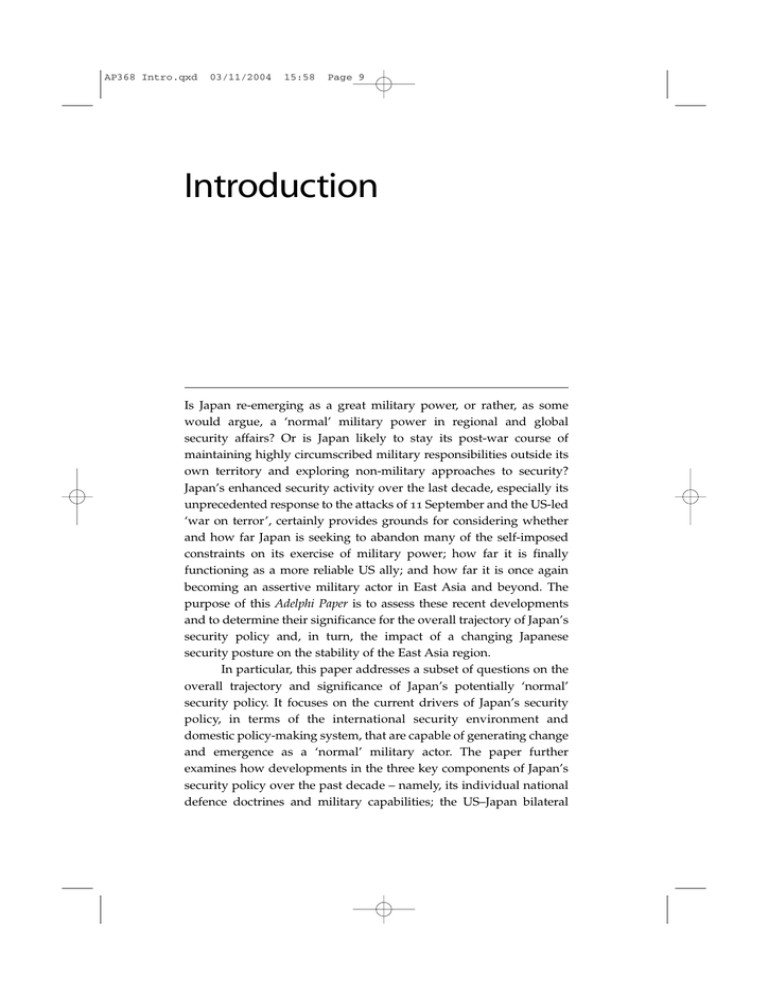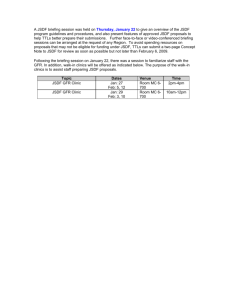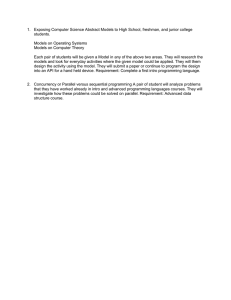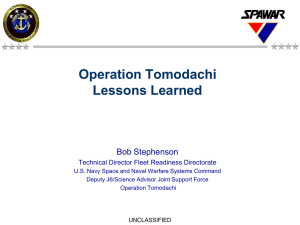Introduction
advertisement

AP368 Intro.qxd 03/11/2004 15:58 Page 9 Introduction Is Japan re-emerging as a great military power, or rather, as some would argue, a ‘normal’ military power in regional and global security affairs? Or is Japan likely to stay its post-war course of maintaining highly circumscribed military responsibilities outside its own territory and exploring non-military approaches to security? Japan’s enhanced security activity over the last decade, especially its unprecedented response to the attacks of 11 September and the US-led ‘war on terror’, certainly provides grounds for considering whether and how far Japan is seeking to abandon many of the self-imposed constraints on its exercise of military power; how far it is finally functioning as a more reliable US ally; and how far it is once again becoming an assertive military actor in East Asia and beyond. The purpose of this Adelphi Paper is to assess these recent developments and to determine their significance for the overall trajectory of Japan’s security policy and, in turn, the impact of a changing Japanese security posture on the stability of the East Asia region. In particular, this paper addresses a subset of questions on the overall trajectory and significance of Japan’s potentially ‘normal’ security policy. It focuses on the current drivers of Japan’s security policy, in terms of the international security environment and domestic policy-making system, that are capable of generating change and emergence as a ‘normal’ military actor. The paper further examines how developments in the three key components of Japan’s security policy over the past decade – namely, its individual national defence doctrines and military capabilities; the US–Japan bilateral AP368 Intro.qxd 03/11/2004 15:58 Page 10 10 Christopher W. Hughes alliance; and multilateralism (in the form of regional security dialogue, the United Nations and multinational coalitions) – have affected its choice of frameworks through which to channel its military power. Finally, the paper concludes by asking if these developments mean that Japan, as is often speculated, is becoming a more independent military actor, or a more committed US ally, or is establishing a new multilateral role, and what sort of impact these developments will have on international security. Is Japan’s security policy moving in radical directions? Following 11 September, the Japanese government under Prime Minister Junichiro Koizumi acted swiftly, passing an Anti-Terrorism Special Measures Law (ATSML) in the National Diet on 29 October. The ATSML has enabled, from November 2001 onwards, the dispatch of Japan Self Defence Forces (JSDF) units to the Indian Ocean area to provide logistical support to US and multinational coalition forces engaged in Afghanistan. On 26 July 2003, the Diet passed a Law Concerning Special Measures on Humanitarian and Reconstruction Assistance (LCSMHRA), which has enabled JSDF deployment to provide logistical support for US and coalition forces in Iraq. At the same time that the Japanese government has pursued initiatives to assist US-led campaigns against terrorism and the proliferation of weapons of mass destruction (WMD) in the Middle East, the resurgence of concerns about North Korea’s nuclear programme since 2002, after the first crisis of 1993–94, has added momentum to the strengthening of Japan’s security posture in East Asia. Between June 2003 and June 2004, the Diet passed, by large majorities, a total of ten related national emergency bills that establish, for the first time in the post-war period, a comprehensive framework to strengthen Japanese government and JSDF domestic authority to respond to a direct attack upon Japan. Japan’s new military assertiveness has been shown by the Japan Coast Guard’s (JCG) sinking of one of North Korea’s ‘spy ships’ in the East China Sea in December 2001; intimations from government officials that they are prepared to consider long-range air strikes against North Korea’s ballistic missile sites if it were to repeat its August 1998 Taepo-dong-1 launch over Japan; and the government’s commitment in December 2003 to procure a Ballistic Missile Defence (BMD) system. This second North Korean nuclear crisis (sparked in 2002–03 by accusations that the North was continuing the clandestine AP368 Intro.qxd 03/11/2004 15:58 Page 11 Japan’s Re-emergence as a ‘Normal’ Military Power 11 development of nuclear weapons, in spite of its pledge following on from the first nuclear crisis of 1993–94 and under the 1994 Agreed Framework to freeze and eventually dismantle its nuclear programme) has also served to rekindle debate among certain policymakers about the acquisition of Japan’s own nuclear deterrent. Japan’s response to instability in the Middle East and Korean Peninsula has been reinforced by its exploration of other areas of military security policy in the post-Cold War period and post-11 September world. The first North Korean nuclear crisis demonstrated the US–Japan alliance’s fundamental lack of political and military operability to respond to regional contingencies. This created momentum for the strengthening of the bilateral alliance through the revision of the Guidelines for Japan–US Defence Cooperation from September 1997 onwards, and then the passage through the Diet in May 1999 of legislation (known in Japan as the ‘Shuhen Jitaiho’) to enable the JSDF to provide logistical support to US forces to defend Japan in the event of regional contingencies around its periphery (‘shuhen’). Japan has also developed, under the auspices of the US alliance network in East Asia and independently, new bilateral military exchanges with Australia, South Korea and individual states of the Association of Southeast Asian Nations (ASEAN). In line with these exchanges, Japanese naval power is set to acquire potential new roles in the interdiction of WMD through the Proliferation Security Initiative (PSI) and anti-piracy patrolling across the East Asia region. Japan has demonstrated a new interest in engaging in multilateral security dialogue via the ASEAN Regional Forum (ARF), and in the IISS-hosted Shangri-La Dialogue since 2002. In the meantime, Japan has bolstered its contribution to United Nations (UN) Peacekeeping Operations (PKO). As a result of its perceived dithering and failure to respond to US and international demands for a ‘human contribution’ during the 1990–91 Gulf War, Japan eventually dispatched minesweepers to the Gulf after the cessation of hostilities and then passed an International Peace Cooperation Law (IPCL) in June 1992 to allow for JSDF dispatch on limited UN PKO missions, the first of these being in Cambodia in 1992–93. In December 2001, Japan further relaxed restrictions on JSDF participation in ‘core’ PKO activities, and dispatched its largest-ever contingent of 680 Ground Self Defence Force (GSDF) troops to assist in non-combat reconstruction activities in East Timor from February AP368 Intro.qxd 03/11/2004 12 Christopher W. Hughes 15:58 Page 12 AP368 Intro.qxd 03/11/2004 15:58 Page 13 Japan’s Re-emergence as a ‘Normal’ Military Power 13 AP368 Intro.qxd 03/11/2004 15:58 Page 14 14 Christopher W. Hughes 2002 onwards. Japan’s expansion of its military responsibilities has been accompanied by the acquisition of new military capabilities and domestic re-examination of doctrinal and constitutional restrictions on the use of military power. The JSDF’s already formidable inventory of high-tech weaponry is being augmented by the procurement of new intelligence satellites, missile defences and command-and control-networks; as well as systems that hint, for the first time in the post-war period, at power-projection capabilities, including in-flight refuelling, long-range air transports, precision-guided munitions (PGM), assault ships and flat-top helicopter transports – the last regarded by some as opening the way for Japan to once again acquire aircraft carriers for the first time since the Second World War. The JSDF and Japan Defence Agency (JDA) have embarked on their own Revolution in Military Affairs (RMA) and force transformation through the adoption of new information technologies, streamlined and joint operations command structures in the shape of the establishment of the Joint Staff Organisation (JSO), and plans for a further revision of the 1995 National Defence Programme Outline (NDPO) – the document that sets out Japanese military doctrine alongside the necessary force structure. Finally, all of this activity has been set against the background of sharpened domestic debate that challenges many post-war security taboos. Japan’s policymakers are questioning the self-imposed ban on Japan’s exercise of the right of collective self defence, and there are ongoing Diet committee and party political investigations into the revision of Article 9 of the Constitution from which spring the various prohibitions and principles that constrain Japan’s exercise of military power. Most recently, throughout 2004, influential Japanese policymakers have begun to push for a lifting of Japan’s ban on the export of armaments. Developments post-11 September, taken together with the past decade security policy activity in the post-Cold War period, suggest that Japan is intensifying its determination to carve out a more prominent military security role, both regionally and globally, to the extent that it may break with past domestic and international constraints. Japan appears to have kicked the ‘Gulf War syndrome’ of 1990–91 and to be shedding its image as a ‘reactive state’ in favour of a more proactive security stance. It appears less reliant on its traditional incremental approach to the expansion of its military AP368 Intro.qxd 03/11/2004 15:58 Page 15 Japan’s Re-emergence as a ‘Normal’ Military Power 15 security role. Japan has shown an uncharacteristic speed and appetite for passing successive rounds of new security legislation. The ATSML required less than three weeks of relatively unimpeded policy deliberation and 33 hours of Diet debate, compared to the tempestuous Diet debates on the IPCL, which took nine months, and the tortuous definitional debates on the geographical and functional scope of the Jitaiho Shuhen , which took close to one year. Japan’s recent security activity embodies also greater geographical and functional substance. Recent JSDF missions in the Indian Ocean represent its first official overseas dispatch during an ongoing conflict, and the JSDF has gained a new mandate to use weapons for the protection of not only its own units but also the military personnel of the US and other states and refugees. Japan appears to be losing its usual reticence about providing active support for its US ally and is learning how to interact militarily in multilateral ‘coalitions of the willing’. The speculation has even been that Japan could function as the ‘Great Britain of the Far East’ – performing the role of a loyal East Asian ally prepared to back US efforts to face down the remaining elements of the ‘axis of evil’. Why Japan matters for international security Japan’s potential re-emergence as a ‘normal’ military power has vital implications for East Asian and global security. Much security analysis of East Asia in recent years has been fixated on the economic and military rise of China and the consequences for regional stability. By contrast, recession-hit Japan has moved out of the media and academic spotlight, with the concomitant result that important developments in its security policy have undergone less consistent scrutiny. This collective myopia towards Japan as a security actor is unwise: in the immediate future, it is more likely to be Japan’s resurgence as a significant military actor, undergirded by massive technological and economic resources, and the possession of genuine regional-wide power-projection capabilities, which will determine the balance of power in East Asia. Japan’s choices about the frameworks within which it deploys its expanded military power will be decisive for regional stability and, indeed, for the international order as a whole. Japan’s future willingness to channel its military capabilities bilaterally via the framework of a strengthened US–Japan alliance will be crucial for the AP368 Intro.qxd 03/11/2004 15:58 Page 16 16 Christopher W. Hughes US in terms of its ability to mobilise regional allies in support of its military hegemonic status in East Asia and globally. In turn, this willingness will be a pivotal factor in determining the outcome of US policy in dealing with North Korea and China. Japanese preparedness to explore new or expanded multilateral military security options will determine, in large part, the course of East Asian security cooperation and will affect the functioning of UN PKO and other security activities. Moreover, if Japan were to show reluctance to harness its military power either through the framework of the bilateral alliance or through East Asian or UN-centred multilateralism, and were to strike out instead in a more independent direction, then the future security scenario in East Asia would be highly uncertain. Just as importantly, Japan’s potential predilection for an augmented military security role will have wider ramifications for alternative approaches to security in a post-Cold War world. This is because, as already indicated, Japan’s devotion of policy energy and material resources to military security may carry a heavy opportunity cost with regard to its ability to pursue simultaneous non-military and economic approaches to security. If Japan, as a major economic power and traditional standard-bearer for alternative security policies, is seen to falter in this regard, then it may also throw into doubt its support for non-military approaches to security, and consequently, the ability of other states and international organisations to pursue them without Japan’s involvement. Structure and arguments Japan’s record of military activity over the past decade and since 11 September, combined with its intrinsic importance as a regional and now global military actor, and the sense that Japan is poised on the brink of major decisions about its military status, make a detailed analysis of Japan’s security policy vital at this juncture. As stated above, the objective of this Adelphi Paper (the first in more than ten years to exclusively address the issue of Japan, and coinciding with the fiftieth anniversary of the establishment of the JSDF, and release of a revised NDPO) is to take stock of recent developments and to investigate in depth exactly what they mean for the future trajectory of Japan’s security policy, and its repercussions for East Asian security and beyond. The paper addresses these overarching questions in a series of chapters that analyse key issues in Japan’s developing AP368 Intro.qxd 03/11/2004 15:58 Page 17 Japan’s Re-emergence as a ‘Normal’ Military Power 17 military posture, and which are then used as components to build a larger explanation of the overall direction of Japanese policy. Chapter 1 investigates the domestic and international framework that has determined the past course of Japanese security policy in order to contextualise and gauge the significance of recent developments. In particular, it focuses on the evolution of Japan’s military role from the post-war baseline of the Yoshida Doctrine. Chapter 2 then considers in what ways the changing international structure surrounding Japan, and especially China and North Korea’s military behaviour, and the events of 11 September and the response of the US and UN, are driving Japan’s interest in expanding its military role. The chapter also examines Japan’s domestic debate on a ‘normal’ security role, the evolving policy structure, and the shifting influence among key policymakers and their attitudes to the enhanced exercise of military power. It considers whether Japan’s security policy initiatives are simply the product of the extraordinary international and domestic circumstances of the post-11 September security environment and Koizumi’s premiership, or if they represent the culmination of more fundamental trends making for a sea change in its defence stance. Chapter 3 probes developments in Japan’s national military capabilities and how they are affecting the orientation and autonomy of its military policy. Among other issues, the chapter explores Japan’s enactment of new legal frameworks and military doctrines, the procurement of new defensive and power projection capabilities, the ongoing reorganisation of the JSDF, and the debate on a Japanese nuclear option. Chapter 4 analyses the strengthening of the Japan–US alliance framework in the post-Cold War period, how far Japan has been willing to integrate its military capabilities with those of its bilateral alliance partner, and the resultant implications for Japan’s independence as a military actor and the maintenance of US power in East Asia. The chapter includes coverage of the revised Guidelines for Japan–US Defence Cooperation, BMD, Okinawa and bases issues, US force realignments and Japan’s attitude to US-led wars in Afghanistan and Iraq. Chapter 5 examines Japan’s experimentation with multilateral security frameworks in East Asia and under UN and US auspices, and the degree to which these could influence the trajectory of Japanese military policy by creating alternative security paths or by reinforcing existing bilateral and national frameworks. Japan’s role in the ARF, AP368 Intro.qxd 03/11/2004 15:58 Page 18 18 Christopher W. Hughes UN PKO and multinational ‘coalitions of the willing’ in Afghanistan and Iraq is subject to scrutiny. Extrapolating from these chapters the key determinant variables and trends in Japan’s security policy, the principal argument of this paper is that Japan is undoubtedly moving along the trajectory of becoming a more assertive or ‘normal’ military power, and that the post-11 September security environment has greatly accelerated this trend. Japan has set crucial legal and functional precedents for JSDF deployment in Afghanistan and Iraq, which presages an expanded role for Japan’s military power in East Asia and in other regions. These trends have been reinforced by the upgrading of the US–Japan alliance over the last decade, and Japan’s strengthening of its independent military capabilities. Japan’s renewed fears about North Korea’s nuclear programme, and longer-term concerns about China’s military intentions, are further propelling its security policy along this more muscular military path. If either of these sources of instability were to become clear and immediate threats to Japan, then, combined with the trends that have served to raise Japan’s national military profile in recent years, Japan could quickly reveal itself as a fully fledged military great power. While Japan is poised to undertake new and expanded military responsibilities, it is not likely to channel its military power through greatly different frameworks than at present. Based on current trends, Japan will probably seek to further strengthen the US–Japan bilateral alliance as its main framework for the utilisation of military power. It is unlikely to devote the greatest share of its military energies to East Asian or UN-centred multilateral frameworks, given the expectation that these cannot provide sufficient guarantees for national defence. Japanese fears of sparking regional instability are also likely to rule out its adopting a more independent security stance. Japan will continue (with, arguably, increasing difficulty) to retain multilateralism and an autonomous defence posture as potential security options to hedge against total dependence on the US, but will only opt for these if the US is seen to fail it as a reliable or indomitable ally. In pursuing this path of ever closer security cooperation with the US, Japan will be forced to discard many of the tenets of the Yoshida Doctrine, and may bind itself inextricably into the bilateral alliance framework. The clear implication for regional and global security is that an augmented US–Japan alliance, with Japan a more active and AP368 Intro.qxd 03/11/2004 15:58 Page 19 Japan’s Re-emergence as a ‘Normal’ Military Power 19 powerful player within it, will only become an ever more formidable presence in determining international stability.






